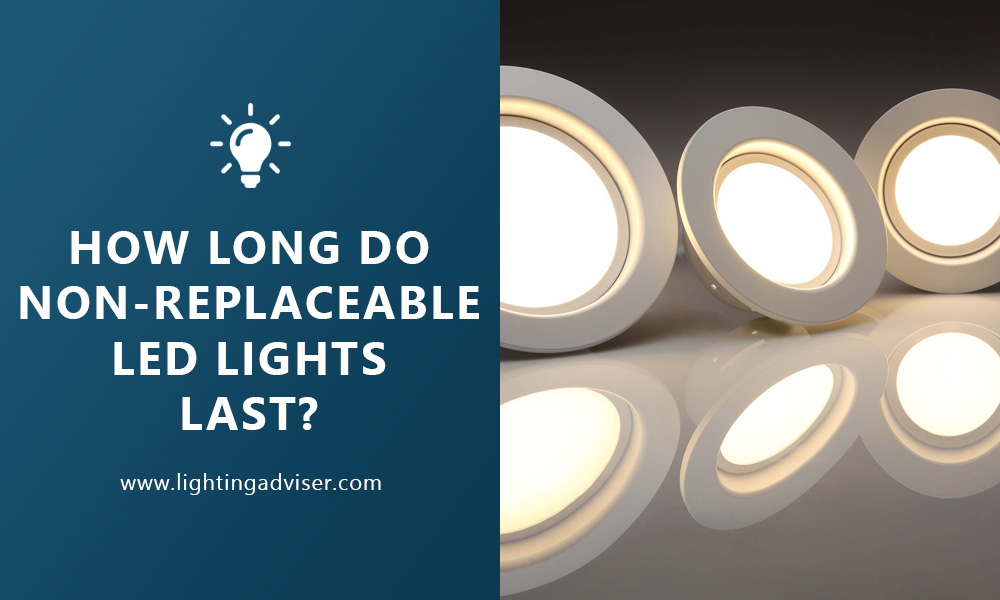Many lighting fixtures now come with integrated, non-replaceable LEDs. These allow for really compact designs and you no longer need to worry about purchasing the correct bulbs.
However, since the bulbs cannot be replaced, you would be right to be concerned about the lifespan of these lights. So how long do non-replaceable LED lights last?
Non-replaceable LED lights usually have an estimated lifespan of between 30,000 – 60,000 hours. This is higher than standard replacable LED bulbs and considerably more than the old incandescent bulbs.
In the rest of this guide, we’ll take a look at the pros and cons of non-replaceable LED lights and how to extend their lifespan.
Contents

How Long Do Non-Replaceable LED Lights Last?
One of the biggest selling points of lighting fixtures with integrated LEDs is their lifespan which is usually estimated to be between 30,000 – 60,000 hours.
The table below shows how that translates into years based on usage per day.
| 30,000 hrs | 40,000 hrs | 50,000 hrs | 60,000 hrs | |
|---|---|---|---|---|
| 4 hrs per day | 20 yrs | 27 yrs | 34 yrs | 40 yrs |
| 8 hrs per day | 10 yrs | 13.5 yrs | 17 yrs | 20 yrs |
| 24 hrs per day | 3.5 yrs | 4.5 yrs | 5.5 yrs | 7 yrs |
So how does this compare to other bulbs? Well incandescent bulbs usually have a lifespan of 1,000 – 2,000 hours so they’re deffinetely the winner there. Standard replaceable LED bulbs usually have a lifespan of 10,000 – 15,000 hours so again, the non-replaceble LED lights come out on top.
It’s important to note that these numbers are based on manufacturers estimations and there are factors that can reduce the lifespan considerably such as heat, and frequent usage.
The estimates should only be used as a rough guide and you should pay attention to the warranty the manufacturer offers in case the lights don’t last their expected lifespan.
Pay attention to warranties:
If a bulb fails in an integrated fixture you will need to replace the whole fixture. Pay attention the the warranty so you won’t be out of pocket if a bulb fails after a short period of time.
Integrated LED Lights Pros & Cons
Pros
- Longer lifespan – LED bulbs in general have long lifespans, but integrated LEDs are often even more durable due to their design offering greater protection against the elements.
- Greater design flexibility – When manufactures don’t have to worry about catering to fitting standard light bulbs, they have more freedom over the design of the fixture. This also means the light fixture can be more compact than traditional fixtures would allow.
- All-in-one – With an integrated light fixture, you don’t need to worry about finding a bulb that’s the right size and has the correct fitting.
Cons
- More expensive upfront cost – Integrated LED light fixtures tend to be more expensive.
- Non-Replaceable – If a bulb fails in an integrated LED light fixture, it’s bad news as you obviously can’t replace it. When purchasing an integrated LED light fixture, make sure to choose one with a good warranty.
- No customization – An advantage to traditional, replaceable light bulbs is that you have the ability to choose and change the type of bulb (e.g. size, brightness, temperature). With an integrated bulb, you’re stuck with whatever bulbs the fixture comes with.
Extending the Lifespan of Non-Replaceable LED Lights
LED lights have a very good life span as it is, but when the bulbs are non-replaceable it makes sense to take a few extra steps to extend their lifespan. Here are a few things you can do to get the most out of the bulbs.
- Only Leave Lights On When In Use – This is an obvious point but worth mentioning. If you’re conscious about the lifespan of your integrated LED lights, make sure to keep them turned off when not in use. Using a timer to automatically shut the lights off when not in use is a good way to manage this.
- Avoid Frequently Turning Lights On & Off – Frequently turning LED lights on and off can put strain on them and reduce the lifespan. Whilst it’s a good idea to turn them off when not in use, if you know you will be turning them back on soon, it’s often better to just leave them on.
Is There Any Way To Replace Integrated LED Bulbs?
Unfortunately, if a bulb dies in an integrated LED light fixture it can’t be easily replaced. If this happens, the first thing you want to do is check the warranty as you may be entitled to a replacement.
If the product is out of warranty, it’s still worth contacting the seller or manufacturer as there may be a way to replace the bulbs by dismantling the fixture but this might not be possible.
Final Thoughts
To wrap it up, non-replaceable LED lights tend to have long lifespans compared to incandescent bulbs and even standard LED bulbs.
However, make sure you pay attention to the warranty before purchasing because if a bulb fails, you will need to replace the whole fixture.
